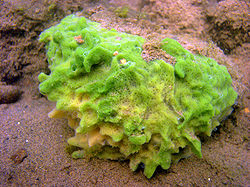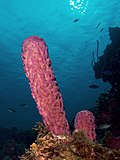[citation needed] Archaeocytes (from Greek archaios "beginning" and kytos "hollow vessel") or amoebocytes are amoeboid cells found in sponges. They are...
2 KB (224 words) - 08:07, 1 May 2025
They form by migration of food-filled archaeocytes, also called amoebocytes, into discrete masses. This archaeocyte core becomes enveloped in several different...
12 KB (1,366 words) - 03:03, 10 March 2025
contract. "Grey cells" act as sponges' equivalent of an immune system. Archaeocytes (or amoebocytes) are amoeba-like cells that are totipotent, in other...
133 KB (13,676 words) - 23:29, 30 April 2025
them by phagocytosis. Sponges exhibit a totipotent cell type known as archaeocytes, capable of transforming into the feeding cells or choanocytes. Amoeboid...
51 KB (4,923 words) - 10:13, 25 May 2025
non-living material, the mesohyl contains living cells called archaeocytes. Archaeocytes are specialized cells that can modify themselves according to...
21 KB (2,071 words) - 05:41, 11 March 2025
change into other cell types. In sponges, amebocytes, also known as archaeocytes, are cells found in the mesohyl that can transform into any of the animal's...
4 KB (376 words) - 22:30, 21 February 2025
sponges. Spicules are formed by sclerocytes, which are derived from archaeocytes. The sclerocyte begins with an organic filament, and adds silica to it...
72 KB (7,864 words) - 21:07, 23 May 2025
choanocytes. They contain a matrix composed of proteins and spicules. Archaeocytes are special types of cells, in that they can transform into all of the...
37 KB (4,562 words) - 17:17, 26 May 2025
then capture the sperm and transport them to the eggs of the sponge via archaeocytes. Fertilization takes place in the mesenchyme of the sponge. They then...
6 KB (697 words) - 21:49, 26 May 2025








